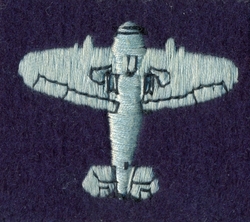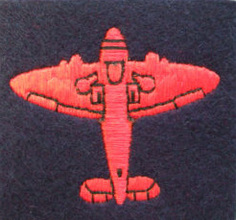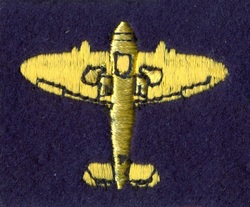BREAST BADGES
ROC BREAST BADGE (PRE-1941)
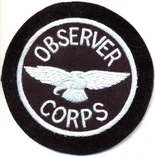
The Observer Corps breast badge was issued pre-1941.
ROC BREAST BADGE (1941)
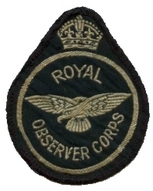
The ROC breast badge was issued from 1941 through to 1947. The first badges were issued to be used on overalls, however with the gradual introduction of the RAF style (No.2 Battledress) tunic ("Hairy Mary") the badge found its way onto that uniform. From 1941 the control of the Corps was transferred to the Royal Air Force and the influence of such may be seen on the badge with the use of the "bird of Prey rather than the standard ROC badge.
ROC BREAST BADGE (1985/6)

These badges were issued during mid-1980's. They were worn by post observers on standard issue green overalls for use within the underground monitoring posts.
| Badge location on Overall | |
| File Size: | 1425 kb |
| File Type: | jpg |
SHOULDER BADGES
ROC SHOULDER BADGE

These were located on the shoulder of each arm. The number represents the group to which the wearer belonged. '23' in this case relates to 23 Group - Durham.
'SEABORNE' SHOULDER BADGE

ROC Seaborne shoulder flash, worn below the "Royal Observer Corps" shoulder flash and group numerals, on both sleeves
BERET / CAP / LAPEL BADGES
OBSERVER CORPS BERET / LAPEL BADGE
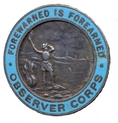
This badge was issued to all Observers and was generally worn on their beret or as a lapel badge. Note the reference to 'Observer Corps'. The 'Royal' title was issued to the Corps by King George VI in 1941. These badges were usually made from sterling silver.
ROC LAPEL BADGE (QUEENS CROWN)
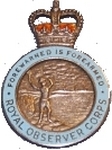
Following on from the beret / lapel badges from before the war, after 1941, the badges were changed to represent the 'Royal' significance of the Corps. This example shows a Queens Crown lapel badge which were issued after the Queens Coronation in 1953. Badges made pre-1968 were generally made of hallmarked sterling silver, however post-1968 badges were made from cast metal.
ROC BERET BADGE (KINGS CROWN)
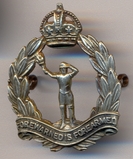
Beret badges were developed to follow a similar RAF style. The badge represented the elizabethan firelighter with either kings crown or queens crown on the top. This example shows the kings crown version from 1941 to 1952. The difference between the two crowns may clearly be identified when the crown is compared to the image above.
PROFICIENCY BADGES
SPITFIRE AWARD BADGES
The need for all observers to be able to clearly identify enemy as well as friendly aircraft formed the major roles of the ROC during its formative years through to its initial stand-down in 1991. As a result, aircraft recognition formed the basis of training of the Corps throughout this period. Initial recognition tests were undertaken during World War 2 and used to assess the overall level of competency of the Observers. This was undertaken using a set of silhouette cards of aircraft in which the Observers had to clearly identify correctly. Later tests were undertaken using photographic slides which were projected onto a screen using a "Flash Trainer" projector.
The move towards nuclear fallout monitoring and public warning from 1955 led to such tests being modified to incorporate a mix of aircraft recognition (generally focusing on aircraft of the Warsaw Pact nations) and a series of questions relating to nuclear warning and monitoring. All observers were required to undergo such tests in order to maintain their knowledge and expertise to carry out their role, and depending upon the number of tests successfully completed determined whether they were issued with a Blue, Red or Gold coloured Spitfire badge which was to be worn on the sleeve of the Observer Corps uniform.
To be successfully awarded the Blue Spitfire badge, the Observer was required to gain a single 'Master Pass' i.e. a score of 90% or above. After five successful 'master passes' of the test led to the award of a red spitfire badge and after a maximum 25 'master passes' led to gold spitfire badge. Subsequent successful 'master passes' resulted in the award of gold stars to a maximum of three followed by the Gold Spitfire. The following table lists the awards issued for successive successful passes of the Master Test.
Number of Master Test Passes1 5 10 15 20 25 30 |
Description of BadgePale Blue embroidered Spitfire badge Red embroidered Spitfire badge Red embroidered Spitfire badge plus one red embroidered star Red embroidered Spitfire badge plus two red embroidered stars Red embroidered Spitfire badge plus three red embroidered stars Gold embroidered Spitfire badge Gold embroidered Spitfire badge plus one gold embroidered star |
| Guide to fitting - 1972 Pattern Uniform | |
| File Size: | 1437 kb |
| File Type: | |
| Location of badges on uniform | |
| File Size: | 1947 kb |
| File Type: | jpg |
